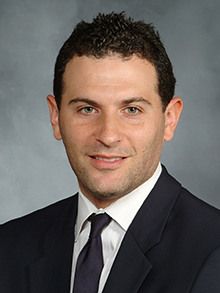
One of the most exciting things in neurosurgery – in fact, in medicine in general – is discovering a genuinely different approach to treating a condition. It’s extremely gratifying to find a better way to treat your patients, especially when it means sparing them open surgery and offering a minimally invasive alternative. When that finding also happens to completely upend traditional thinking about a common condition, it’s quite remarkable indeed.
That’s what happened recently when I started testing a technique called middle meningeal arterial (MMA) embolization on subdural hematomas. (See news item on this new procedure.) We frequently use MMA embolization on other cerebrovascular conditions, including AV fistulas and meningiomas, and know it to be safe and effective.
As a neurosurgeon who specializes in cerebrovascular disorders, I’ve seen firsthand how the field is moving more and more toward these kinds of image-guided procedures. I use them all the time, but I still never fail to be amazed at how we can perform advanced procedures from inside the blood vessels. Today we can insert a microcatheter into the femoral artery in the thigh and make our way up into the brain to make even complex repairs; our patients can walk out of the hospital just hours later.
This approach relies on nice, wide arteries to provide a path up to the brain, which meant that one of the most common cerebrovascular conditions couldn’t benefit from it. Hundreds of thousands of Americans each year need treatment for subdural hematomas – pools of blood that form between the brain and its outer covering, the dura – and many of them face open surgery to remove them. It has been common knowledge that these hematomas were venous in nature – and since they were a disorder of the veins, our intra-arterial path to the brain couldn’t help us. Turns out common knowledge was missing a thing or two.
It’s true that subdural hematomas are venous in origin, but recent analysis has shown that they develop new blood vessels themselves. Surprisingly, that new vasculature seems to penetrate the dura, where it connects with the middle meningeal artery. As a surgeon who has operated on these hematomas for years, I observed how friable and vascular the membranes surrounding subdural hematomas can be; there must be an arterial input to the development and growth of this venous pathology. That raised the possibility of reaching – and repairing – the hematoma using minimally invasive arterial embolization from the MMA. And it works.
This finding has completely turned upside down the way we have thought about this disease. The fact that arterial embolization can cure this pathology shows that arteries play a major role in their development. This is a new finding that contradicts nearly fifty years of education and assumption.
This has potentially enormous ramifications for patients, especially those over age 65, who have chronic subdural hematomas. Some estimates put the annual incidence of subdural hematomas at more than 58 per 100,000 in those over 65. Mortality rates are as high as 13 percent, since these tend to be complicated cases in patients with multiple other conditions. These subdurals need to be treated, but surgical risk is also highest in this patient population. The option of having a new front-line treatment, with little surgical risk and excellent outcomes, makes a huge difference in how we treat these patients.
Even more importantly, it makes an enormous difference in the patient experience – embolization is easier than open surgery on patients, especially older ones, and hospitalization time is greatly reduced. Recovery time is much faster. And the risk of infection or other complications is minimized. This is truly win-win.
My team and I recently published the results of our first few cases in the journal Operative Neurosurgery, and since publication I’ve treated several dozen other patients with this new approach, without a single complication. I’m now conducting a formal clinical trial here – the only one in the country – to gather the data we need to help make this the new standard of care. MMA embolization in our experience has so far shown more than 90 percent effectiveness for treating subdural hematomas without surgery in select patients, which is a truly significant success rate for a new first-line treatment. And nothing about this procedure precludes using traditional open surgery if a patient does not get better.
I continue to be grateful for the remarkable colleagues that help make these advances possible, and for the world-class facility I work in that provides me with the tools I need to succeed. And I’m honored to be able to find new ways to treat patients more effectively.
Read the abstract of the Operative Neurosurgery paper
More about Dr. Knopman | More about subdural hematomas